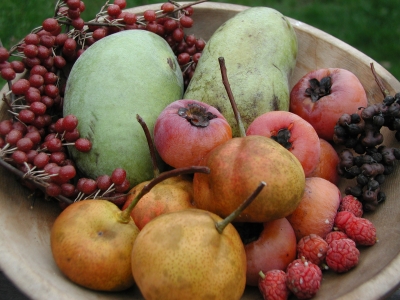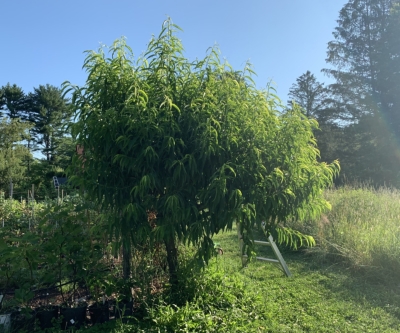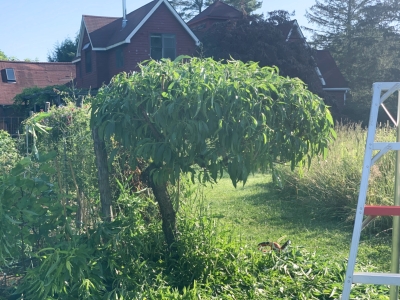FRUITS IN THE KITCHEN AND FRUITS ON THE TREE
Call for Recipes
About 30 years ago I wrote a book about fruits that were uncommon yet were uncommonly delicious and uncommonly easy to grow. That book has since gone out of print. It will soon be back in print, updated with additional “uncommon” fruits and, this time around, recipes.

The fruits I wrote about are all excellent eaten fresh. I am quite good at growing fruits; not so for doing anything else with them beyond transporting them from hand to mouth.
I am eliciting recipes from chefs and amateurs who have access to any of these fruits and can conjure up delicious jams, soups, tarts, salads, desserts, etc. — savory or sweet — that truly highlights their unique flavors. (I’ve read too many recipes that take a smidgen of fruit and stir it up with plenty of flour, sugar, butter, cream, whatever; to me that’s not really highlighting a fruit’s unique flavor or texture.)
I will, of course, credit any recipes published with their inventor as well as affiliations. Here’s a list of the fruits. It’s a list chapter headings and subheadings from the book. I have grown all of them and can vouch for their fresh flavors. So please send me your recipes, as “reply” to this blog or, preferably, as email.

OLYMPUS DIGITAL CAMERA
•Juneberry: A Cosmopolitan Blue Berry (Amelanchier spp.)
•Beach Plum: A Tasty Fruit Not Just for the Beach (Prunus maritima)
•Alpine and Musk Strawberries: Diminutive Delectables (Fragaria vesca, F. moschata)
•Raisin Tree: Candied Fruit for the Picking (Hovenia dulcis)

•Lingonberry: Dainty Looks, Sturdy Disposition, and Tasty Berries (Vaccinium vitis-ideae)
•Actinidia: Emeralds in the Rough (Actinidia arguta, A. kolomikta)
•Mulberry: A Summer Fruit-of-Many-Colors (Morus spp.)
•Kaki and American Persimmons: Fruits of the Gods (Diospyros kaki, D. virginiana)
•Elaeagnus: Gumi, Autumn Olive, and Russian Olive (Elaeagnus spp.)
•Gooseberry: Fruit with a Checkered Past (Ribes uva-crispa, R. hirtuellum)
•Maypop: A Passionflower for the North (Passiflora incarnata)
•Che: Chewy Dollops of Maroon Sweetness (Cudrania tricuspidata)
•Black Currant: Fruit from Fragrant Bushes (Ribes nigrum, R. odoratum)
•Nanking Cherry: Cherries on a Bush (Prunus tomentosa)

•Cornelian Cherry: From the Shores of Ancient Greece (Cornus mas)
•Currants, Red and White: Sprightly, Translucent Jewels (Ribes petraeum, R. rubrum, R. sativum)
•Asian Pear: The Crunch Pear (Pyrus pyrifolia, P. ussuriensis, P. × bretschneideri
•Jostaberry: The Gooseberry and Black Currant Hybrid (Ribes nidigrolaria)
•Lowbush Blueberry: More American Than Apple Pie (Vaccinium angustifolium)
•Jujube: The Chinese Date (Ziziphus jujuba)

•Shipova: A Sweetie with a Blush (×Sorbopyrus auricularis)
•Medlar: Lost in the Middle Ages (Mespilus germanica)
•Seaberry: Northern flavor of oranges and pineapple (Hippophae rhamnoides)
•Black raspberry: Wild, but Worthy of Cultivation (Rubus occidentalis)
Hedging my Bets
This year has been such a bountiful year for fruits that even my peach tree has set fruit. Peaches are particularly pretty trees, in bloom showered with pink blossoms and the rest of the season with their healthy-looking, lance shaped leaves that gracefully curve downwards. Since I rarely get fruit from my tree — late frost, plum curculio, brown rot, and oriental fruit moth, among other maladies — I actually grow it mainly as an ornamental.
 Because I grow it mostly as an ornamental and because it grows right near one corner of my vegetable garden, I don’t want it to grow too large. Last year at about this time I decided to hedge its crown into a pleasing shape.
Because I grow it mostly as an ornamental and because it grows right near one corner of my vegetable garden, I don’t want it to grow too large. Last year at about this time I decided to hedge its crown into a pleasing shape.

Peaches bear fruit on one year old wood. I figured the unpruned lower portions of the hedged branches would set fruit buds in case the tree, in conjunction with the weather and pests, was inclined to set fruit the following year. That’s this year, and the tree is bearing fruit.
I do prune again in spring while the tree is still dormant. Plenty of thinning cuts are needed to decongest the branches. Also some heading cuts to stimulated buds to grow into shoots for the following year’s flowers and fruits.

Yesterday I again hedged the tree down to shapely proportions, allowing it the possibility of a fruitful repeat performance next year.

